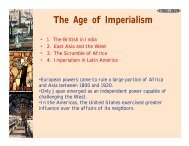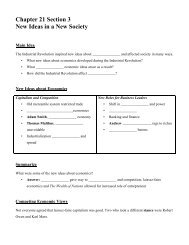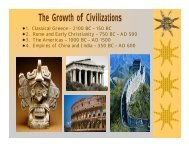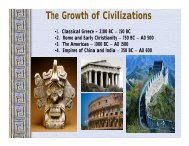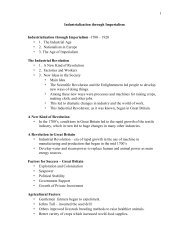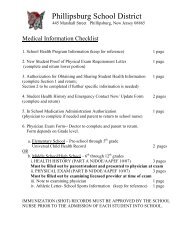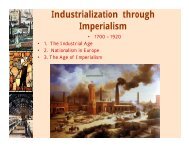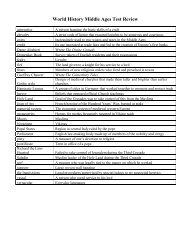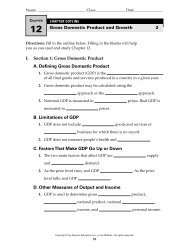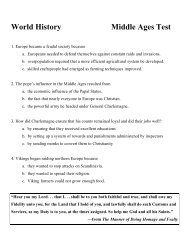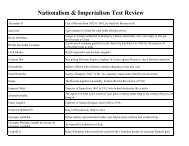Ancient India and China
Ancient India and China
Ancient India and China
Create successful ePaper yourself
Turn your PDF publications into a flip-book with our unique Google optimized e-Paper software.
The Dawn of Civilization<br />
• Prehistory to AD 300<br />
•1. The Beginnings of Civilization – Prehistory to 1000 BC<br />
•2. The <strong>Ancient</strong> Near East – 4000 BC – 550 BC<br />
•3. The Nile Civilizations – 5000 BC – AD 300<br />
•4. <strong>Ancient</strong> <strong>India</strong> <strong>and</strong> <strong>China</strong> 2500 BC – 250 BC
<strong>Ancient</strong> <strong>India</strong> <strong>and</strong> <strong>China</strong><br />
2500 BC – 250 BC<br />
•1. Early <strong>India</strong><br />
•2. Hinduism<br />
•3. Buddhism<br />
•4. <strong>China</strong>’s First Dynasties<br />
•Like Mesopotamia <strong>and</strong> Egypt, <strong>India</strong> <strong>and</strong> <strong>China</strong> were each<br />
home to an early river civilization<br />
•They developed their own governments, languages,<br />
customs, <strong>and</strong> social structures<br />
•Religions <strong>and</strong> philosophies helped shape the lives of people<br />
in Asia
1. Early Civilizations of <strong>Ancient</strong><br />
<strong>India</strong><br />
2500-250 BC<br />
•Early civilization arose in the Indus River Valley, flourished,<br />
<strong>and</strong> then mysteriously died out<br />
•Later, <strong>India</strong>’s Vedic civilization developed a culture based on<br />
old <strong>and</strong> new beliefs (Hinduism)
2500 – 250 BC<br />
Indus River Civilizations<br />
•Indus River Valley<br />
•Subcontinent-large l<strong>and</strong>mass that is part of a continent<br />
•first two Indus River Civilizations were the Harappan <strong>and</strong> Mohenjo-Daro -<br />
Mound of the Dead
Wide View, Mohenjo-Daro<br />
2500 – 250 BC<br />
•The first ruins of the Indus River Valley<br />
•Within these ruins, archaeologists found hundreds of<br />
artifacts, including statues, that can help us learn more<br />
about ancient <strong>India</strong>n life
2500 – 250 BC<br />
Aerial View of Mohenjo-Daro<br />
•Mohenjo-daro was well planned <strong>and</strong> carefully laid out<br />
•Streets ran in grid pattern, north-south, east-west
2500 – 250 BC<br />
Citadel (Fortress) Of Mohenjo-Daro<br />
•In the largest cities, a walled,<br />
elevated citadel, or fortress,<br />
enclosed buildings such as<br />
granaries, warehouses, <strong>and</strong><br />
meeting halls<br />
•Homes, workshops, <strong>and</strong> shrines<br />
were built outside the citadel<br />
•Such planning suggests a<br />
central authority held the<br />
power
Well, Mohenjo-Daro<br />
2500 – 250 BC<br />
•people drew water from community<br />
wells<br />
•Or drew water from smaller wells dug<br />
in the courtyards of their homes
Drain, Harappa<br />
2500 – 250 BC<br />
•Public drainage systems carried away wastewater
2500 – 250 BC<br />
A Main Street, Mohenjo-Daro<br />
•Streets ran in<br />
grid pattern,<br />
north-south, eastwest<br />
•Major avenues<br />
that were twice as<br />
wide as minor<br />
streets
Granery, Mohenjo-Daro<br />
2500 – 250 BC<br />
•Economy was based on agriculture <strong>and</strong> trade<br />
•Most people farmed <strong>and</strong> herded livestock
2500 – 250 BC<br />
The Great Bath, Mohenjo-Daro
Harappan Writing<br />
2500 – 250 BC<br />
•More than 3,000 samples of Indus script have been found, including<br />
many seals that depict realistic animals alongside the writing
Indus Civilization Seals<br />
2500 – 250 BC<br />
Bison Seal, mohenjo daro<br />
Unicorn Seal,<br />
Harappa<br />
Horned-God Seal,<br />
mohenjo daro<br />
•Despite the best efforts of the archaeologists <strong>and</strong> linguists,<br />
however, no one has yet been able to decipher even one word from<br />
any of the seals
2500 – 250 BC<br />
A Male Head, Mohenjo-Daro<br />
•Dravidian-originators of Indus River Civilization
Male Skeleton, Harappa<br />
2500 – 250 BC
Female Skeleton with Child,<br />
Harappa<br />
2500 – 250 BC
•Sometime after 2000 BC, a new people took control of<br />
<strong>India</strong>.<br />
•Aryans – “noble”<br />
•Historians disagree where they came from (either Indo-<br />
European or originated there)<br />
2500 – 250 BC
Aryan (noble) Migration<br />
2500 – 250 BC<br />
•Took control of the Harappan civilization<br />
• pastoral depended on their cattle.<br />
• warriors horse-drawn chariots.
Sanskrit<br />
2500 – 250 BC<br />
•ancient <strong>India</strong>n writing <strong>and</strong> the<br />
classical language<br />
•Means “refined <strong>and</strong> sanctified”
The Vedas<br />
2500 – 250 BC<br />
• 1200 BCE-600 BCE.<br />
• written in SANSKRIT.<br />
• Hindu core of<br />
beliefs:<br />
‣ hymns <strong>and</strong> poems.<br />
‣ religious prayers.<br />
‣ magical spells.<br />
‣ lists of the gods<br />
<strong>and</strong> goddesses.<br />
Rig Veda oldest work.
Varna (Social Hierarchy)<br />
2500 – 250 BC<br />
Priests <strong>and</strong> teachers<br />
Brahmins<br />
‣Rigveda – Vedic<br />
society divided into<br />
four social classes<br />
Warriors <strong>and</strong> Rulers<br />
Kshatriyas<br />
Traders, farmers,<br />
herders<br />
Vaishyas<br />
Servants<br />
Shudras<br />
Pariahs [Harijan] Untouchables
Caste System<br />
2500 – 250 BC<br />
WHO IS…<br />
Brahmins<br />
• The mouth?<br />
• The arms?<br />
• The legs?<br />
• The feet?<br />
Kshatriyas<br />
Vaishyas<br />
What is a JATI?<br />
People under their feet or<br />
rule<br />
Shudras
Religions of South Asia<br />
2500 – 250 BC<br />
•Hinduism gave birth<br />
to Buddhism, Jainism,<br />
Sikhism<br />
•Christianity –Jesus<br />
Christ, son of God –<br />
the Bible<br />
•Islam – Muhammadlast<br />
prophet to talk to<br />
Allah – t he Quran<br />
•Do you think Islam<br />
had an effect on<br />
Hindu <strong>India</strong>?
2500 – 250 BC<br />
2. Hinduism?<br />
• The religion of Hinduism developed <strong>and</strong> evolved over a long time in<br />
<strong>India</strong>, giving rise to a variety of beliefs <strong>and</strong> practices <strong>and</strong> to other<br />
religions, including Jainism
2500 – 250 BC<br />
What is Hinduism?<br />
• One of the oldest religions of humanity<br />
• The religion of the <strong>India</strong>n people<br />
• Its origins are difficult to trace<br />
Brahman
2500 – 250 BC<br />
How did Hinduism begin?<br />
• No particular founder<br />
• Indus River Valley Civilization >5000 years ago<br />
• Aryans enter 4000 - 3500 years ago<br />
• Vedic Tradition 3500 – 2500 years ago:
2500 – 250 BC<br />
What do Hindus believe?<br />
• One impersonal Ultimate Reality – Brahman -the<br />
creator<br />
• Atman, the soul, is Brahman trapped in matter<br />
• Reincarnation – reborn into this world lifetime<br />
after lifetime (Samsara)<br />
• Karma – spiritual impurity due to actions keeps<br />
us bound to this world (good <strong>and</strong> bad)
2500 – 250 BC<br />
How does Hinduism direct<br />
life in this world?<br />
– Dharma-set of spiritual duties-based on class <strong>and</strong> station<br />
– Four “stations” of life (Caste) - priests & teachers, nobles &<br />
warriors, merchant class, servant class<br />
– Four stages of life – student, householder, retired, renunciant
2500 – 250 BC<br />
What are the Sacred Texts?<br />
• Shruti (“heard”) – oldest, most<br />
authoritative:<br />
– Four Vedas (“truth”) – myths, rituals,<br />
chants<br />
– Upanishads - metaphysical<br />
speculation<br />
• Smriti (“remembered”) – the Great<br />
<strong>India</strong>n Epics:<br />
– Ramayana<br />
– Mahabharata (includes Bhagavad-<br />
Gita)
2500 – 250 BC<br />
What are the spiritual<br />
practices of Hinduism?<br />
• Yoga-meditation in order to attain moksha<br />
• Ultimate goal of life – to release Atman <strong>and</strong> reunite with the divine,<br />
becoming as one with Brahman (Moksha)
Who do Hindus worship? –<br />
2500 – 250 BC<br />
the major gods of the Hindu Pantheon<br />
Brahma, the creator god
Who do Hindus worship? –<br />
2500 – 250 BC<br />
the major gods of the Hindu Pantheon<br />
Vishnu, the preserver god<br />
Incarnates as ten avatars (descents) including:<br />
Rama (featured in the Ramayana)<br />
Krishna (featured in the Mahabharata)<br />
(Each shown with his consort, Sita <strong>and</strong> Radha, respectively)
Who do Hindus worship? –<br />
2500 – 250 BC<br />
the major gods of the Hindu Pantheon<br />
Shiva, god of constructive destruction (the transformer)<br />
Appears as Shiva Nataraj,<br />
lord of the dance of creation…<br />
<strong>and</strong> with his wife, Parvati, <strong>and</strong> son Ganesha<br />
(the elephant headed remover of obstacles)
What about the goddesses?<br />
Devi – the feminine divine<br />
2500 – 250 BC<br />
•Saraswati, goddess of wisdom, consort of Brahma
2500 – 250 BC<br />
What about the goddesses?<br />
Devi – the feminine divine<br />
Lakshmi, goddess of good fortune, consort of Vishnu
2500 – 250 BC<br />
What about the goddesses?<br />
Devi – the feminine divine<br />
•Parvati, divine mother, wife of Shiva
2500 – 250 BC<br />
What about the goddesses?<br />
Devi – the feminine divine<br />
Durga, protectress<br />
Plus about 330 million other deities<br />
Kali, destroyer of demons
All these deities are but<br />
Manifest forms (attributes<br />
<strong>and</strong> functions) of the<br />
impersonal Brahman
Jainism<br />
2500 – 250 BC<br />
•500 BC – a group of Hindus broke away<br />
•Mahavira – Jainism – thought Hindus placed too much<br />
emphasis on ritual<br />
Plus about 330 million other deities<br />
•Ahimsa- nonviolence towards living things; avoid stealing<br />
<strong>and</strong> tell the truth
2500 – 250 BC<br />
3. Buddhism<br />
•Buddhism, which<br />
teaches people that<br />
they can escape the<br />
suffering of the world<br />
through the Buddhist<br />
teachings, developed in<br />
<strong>India</strong> <strong>and</strong> spread to<br />
other parts of Asia
2500 – 250 BC<br />
Siddhartha Gautama (563-483 BCE)<br />
<br />
<br />
<br />
<br />
Unlike Hinduism,<br />
Buddhism can be<br />
traced to one single<br />
founder, Siddhartha<br />
Gautama<br />
Prince of a small<br />
kingdom; he lived<br />
sheltered life <strong>and</strong><br />
sought the answer to<br />
ending suffering<br />
After years of<br />
meditation searching<br />
for Nirvava he<br />
became Enlightened<br />
He transformed into<br />
Buddha
What is the fundamental cause of<br />
all suffering?<br />
2500 – 250 BC<br />
Desire!<br />
<br />
Therefore, extinguish the self, don’t obsess about<br />
oneself. Give up all materials <strong>and</strong> possessions of the<br />
world.
2500 – 250 BC<br />
Four Noble Truths<br />
‣ There is suffering in the world. To live is to suffer.<br />
(Dukkha)<br />
‣ The cause of suffering is self-centered desire <strong>and</strong><br />
attachments. (Tanha)<br />
‣ The solution is to eliminate desire <strong>and</strong> attachments.<br />
(Nirvana = “extinction”)<br />
‣ To reach nirvana, one must follow the Eightfold Path.
Eightfold Path<br />
2500 – 250 BC<br />
Right Underst<strong>and</strong>ing<br />
Right Intention<br />
Right Speech<br />
Right Action<br />
Right Livelihood<br />
Right Effort<br />
Right Concentration<br />
Right Mindfulness
2500 – 250 BC<br />
Eightfold Path<br />
Nirvana<br />
The union with the ultimate spiritual reality.<br />
Escape from the cycle of rebirth. Reincarnation
2500 – 250 BC<br />
Types of Buddhism<br />
<br />
<br />
<br />
<br />
Therevada<br />
Buddhism<br />
Mahayana<br />
Buddhism<br />
Tibetan<br />
Buddhism<br />
Zen<br />
Buddhism
2500 – 250 BC<br />
Theravada Buddhism<br />
<br />
<br />
<br />
<br />
<br />
<br />
<br />
The oldest school of Buddhism.<br />
The “Way of the Elders” or the “Small Vehicle.”<br />
Found in southern Asia.<br />
The monastic life is the best way<br />
to achieve nirvana.<br />
Focus on wisdom <strong>and</strong> meditation.<br />
Goal is to become a “Buddha,” or “Enlightened One.”<br />
Over 100,000,000 followers today.
2500 – 250 BC<br />
Mahayana Buddhism<br />
<br />
<br />
<br />
<br />
<br />
The “Great Vehicle.”<br />
Founded in northern Asia (<strong>China</strong>, Japan).<br />
Buddhism “for the masses.”<br />
Seek guidance from Boddhisatvas, wise beings.<br />
Goal: Not just individual escape from the wheel, but<br />
the salvation of all humanity through self-sacrifice of<br />
those enlightened few.
2500 – 250 BC<br />
Tibetan Buddhism<br />
The “Diamond Vehicle.” [Vajrayana]<br />
Developed in Tibet in the 7c CE.<br />
A mix of Theravada <strong>and</strong> Mahayana.<br />
Boddhisatvas include Lamas, like<br />
the Dalai Lama.<br />
The Tibetan Book of the Dead<br />
[Bardo Thodol].
The Dalai Lama<br />
2500 – 250 BC
2500 – 250 BC<br />
Zen Buddhism<br />
The “Meditation School.”<br />
Seeks sudden enlightenment [satori] through meditation, arriving at<br />
emptiness [sunyata].<br />
Use of meditation masters [Roshi].<br />
Beauty, art, <strong>and</strong> aesthetics:<br />
• Gardens.<br />
• Archery.<br />
• Tea ceremony.<br />
• Calligraphy.
Buddhism in America (1999)<br />
2500 – 250 BC
Relieve Stress & Meditate:<br />
Get a Mantra !<br />
2500 – 250 BC<br />
Ohm...mani...padme...hung...<br />
Hail to the jewel in the lotus!
4. <strong>China</strong>’s First Dynasties<br />
2500 – 250 BC<br />
2500-250 BC<br />
•<strong>China</strong>’s river valley civilizations built the foundations of a long shared<br />
Chinese culture.<br />
•The achievements of the Shang <strong>and</strong> Zhou dynasties can be felt to this<br />
day.
Neolithic <strong>China</strong><br />
2500 – 250 BC<br />
Sinanthropus<br />
pekinesis<br />
•“Peking Man”<br />
(750,000 – 500,000 BCE)<br />
•<strong>China</strong>’s isolation helped early<br />
civilization develop <strong>and</strong> grow<br />
without foreign intrusion for<br />
several centuries.
Yellow River Civilization<br />
2500 – 250 BC<br />
•<strong>China</strong> first civilizations, like <strong>India</strong>, Egypt, <strong>and</strong> the Middle East<br />
began around fertile river valleys.<br />
•Chang Jiang <strong>and</strong> Huang He (Yellow River) – annual floods<br />
•Loess-fine dusty soil that was carried into <strong>China</strong> by desert winds
Pan-Gu<br />
2500 – 250 BC<br />
•Mythical Creator of the Universe
Yu, the Great<br />
2500 – 250 BC<br />
•Founder of the Asia
“Huangdi” – Emperor<br />
2500 – 250 BC<br />
• The “Yellow Emperor.”<br />
• Legend has it that he ruled for<br />
over 100 years.<br />
• Associated with the invention of<br />
wheeled vehicles, ships
2500 – 250 BC<br />
Emperor Fuxi<br />
• Mythical Asia ruler.<br />
• Taught the Chinese how to read<br />
<strong>and</strong> write, according to legend.
The Shang Dynasty<br />
2500 – 250 BC<br />
•Most historians date the beginning of early Chinese civilization to the<br />
rise of the Shang Dynasty.<br />
•According to legend formed around 1766 BC <strong>and</strong> centered around the<br />
Yellow River valley. During the Bronze Age
Religious Beliefs<br />
2500 – 250 BC<br />
•Much of what historians know about the Shang, comes<br />
from studying royal tombs.<br />
•Shang religion centered around ancestor worship.<br />
•Oracle Bones -bits of animal bones used to advise Shang<br />
•Part of their worship
The Evolution of Chinese Writing<br />
2500 – 250 BC<br />
•Pictographs – the<br />
development of writing tied<br />
into the oracle bones<br />
•Symbols actually written on<br />
the bones to represent<br />
objects or ideas<br />
•Semantic-Phonetics –<br />
eventually replaced<br />
Chinese pictographs
Oracle Bones Calendar<br />
2500 – 250 BC<br />
•Shang astronomers created precise calendars based on the<br />
cycles of the moon.<br />
•They may have created one of the first systems of money.
Axe Scepter 1100 BCE - jade<br />
2500 – 250 BC<br />
Ceremonial Dagger 1028 BCE
Shang Urn<br />
2500 – 250 BC
Shang Bronzes<br />
2500 – 250 BC<br />
•Major advances in bronze making<br />
•Artists created highly decorated bronze vessels <strong>and</strong><br />
objects – used in religious rituals
The Zhou Dynasty<br />
2500 – 250 BC<br />
•The Shang ruled <strong>China</strong> for more than 600 years, but<br />
in 1100 BC, armies from a nearby tribe called the Zhou<br />
invaded <strong>and</strong> established a new ruling dynasty.
Western Zhou: 1027-771 BCE<br />
2500 – 250 BC<br />
•The Zhou held power for<br />
several centuries<br />
•Divided into two periods<br />
•Western Zhou - Xian<br />
•Eastern Zhou - Luoyang
Eastern Zhou: 771-256 BCE<br />
2500 – 250 BC<br />
•During the reign of the<br />
first period, the dynasty<br />
experienced peace.<br />
•Later, however, conflict<br />
arose in <strong>China</strong> <strong>and</strong> the kings<br />
moved east.<br />
•When the Zhou conquered<br />
the Shang, their leaders<br />
worried that the Chinese<br />
would not accept them.<br />
•To gain acceptance, they<br />
introduced the M<strong>and</strong>ate of<br />
Heaven.
The M<strong>and</strong>ate of Heaven<br />
2500 – 250 BC<br />
“T’ien Ming”<br />
1. The leader must lead by ability <strong>and</strong> virtue.<br />
2. The dynasty's leadership must be justified by<br />
succeeding generations.<br />
3. The m<strong>and</strong>ate could be revoked by negligence <strong>and</strong><br />
abuse; the will of the people was important.
•The rise <strong>and</strong> fall of<br />
dynasties in <strong>China</strong> – any<br />
Start here<br />
power that lost power<br />
was because they lost<br />
their m<strong>and</strong>ate<br />
A new<br />
dynasty<br />
comes to power.<br />
The emperor<br />
reforms the govt.<br />
& makes it more<br />
efficient.<br />
2500 – 250 BC<br />
Emperor is<br />
defeated !!<br />
Rebel b<strong>and</strong>s find<br />
strong leader who<br />
unites them.<br />
Attack the emperor.<br />
Poor lose<br />
respect for govt.<br />
They join rebels<br />
& attack l<strong>and</strong>lords.<br />
The<br />
Dynastic<br />
Cycle<br />
Lives of common<br />
people improved;<br />
taxes reduced;<br />
farming encouraged.<br />
Problems begin<br />
(extensive wars,<br />
invasions, etc.)<br />
Taxes increase;<br />
men forced to<br />
work for army.<br />
Farming neglected.<br />
Droughts,<br />
floods,<br />
famines occur.<br />
Govt. increases<br />
spending;<br />
corruption.
Zhou Achievements<br />
2500 – 250 BC<br />
• Pendant of a Dancer - jade<br />
3c BCE (Eastern Zhou)<br />
Ritual Food Vessel,<br />
bronze 11c BCE (Western<br />
Zhou)<br />
•The Zhou learned how<br />
to use iron, which<br />
replace the Bronze Age.<br />
•This strengthened<br />
their empire – catapult<br />
<strong>and</strong> the first cavalry<br />
•Better farming<br />
techniques, roads <strong>and</strong><br />
canals, transportation<br />
<strong>and</strong> communication
Decline of the Zhou<br />
2500 – 250 BC<br />
•Warring States Period – 403 BC – 221 BC – a<br />
number of small states headed by nobles fought for<br />
l<strong>and</strong> <strong>and</strong> power over the king<br />
•Eventually, the Qin dynasty rose to power <strong>and</strong><br />
ended the reign of the Zhou Dynasty.
Major Chinese Philosophies<br />
2500 – 250 BC<br />
•Conflicts during the Warring States Period allowed<br />
many Chinese thinkers to question the nature of society<br />
<strong>and</strong> of people’s roles in it.<br />
•Confucianism – treat one another humanely to improve<br />
society – Kongfuzi<br />
•Daoism – retreat from the laws of society <strong>and</strong> yield to<br />
the laws of nature<br />
•Legalism – the law is the supreme authority – rule with a<br />
firm h<strong>and</strong>
2500 – 250 BC<br />
Confucius<br />
* 551 – 479 B.C.E.<br />
* Born in the feudal state of<br />
Liu.<br />
* Became a teacher <strong>and</strong> editor<br />
of books.<br />
*Express love <strong>and</strong> respect for<br />
one another by practicing<br />
traditional manners
2500 – 250 BC<br />
Major Confucius Principles<br />
Li --> Rite, rules, ritual decorum (Binding force of an<br />
enduring stable society)<br />
Ren --> humaneness, benevolence, humanity<br />
Shu --> Reciprocity, empathy<br />
Do not do unto others what you would<br />
not want others to do unto you.<br />
Yi --> Righteousness<br />
Xiao --> Filial Piety (Respect your elders!)
Five Principle Relationships<br />
2500 – 250 BC<br />
1. Ruler Subject<br />
2. Father Son<br />
3. Husb<strong>and</strong> Wife<br />
4. Older<br />
Brother<br />
5. Older<br />
Friend<br />
Younger<br />
Brother<br />
Younger<br />
Friend
Confucian Temple<br />
2500 – 250 BC
2500 – 250 BC<br />
The Analects<br />
* The single most important Confucian work.<br />
* In Chinese, it means “conversation.”<br />
* Focus on practicalities of interpersonal relationships <strong>and</strong><br />
the relationship of the role of rulers <strong>and</strong> ministers to the<br />
conduct of government.
2500 – 250 BC<br />
Saying from The Analects<br />
* Knowing what he knows <strong>and</strong> knowing what he<br />
doesn’t know, is characteristics of the person<br />
who knows.<br />
* Making a mistake <strong>and</strong> not correcting it, is<br />
making another mistake.<br />
* The superior man blames himself; the<br />
inferior man blames others.<br />
* To go too far is as wrong as to fall short.
Stone Engraved with Confucius<br />
Life Stories<br />
2500 – 250 BC
Confucius Tomb<br />
2500 – 250 BC
2500 – 250 BC<br />
Legalism<br />
* 280? - 233 B.C.E.<br />
* Han Fe Zi.<br />
* Lived during the late Warring<br />
States period.<br />
* Legalism became the political<br />
philosophy of the Qin [Ch’in]<br />
Dynasty.
2500 – 250 BC<br />
Legalism Principles<br />
1. Human nature is naturally selfish.<br />
2. Intellectualism <strong>and</strong> literacy is discouraged.<br />
3. Law is the supreme authority <strong>and</strong> replaces morality.<br />
4. The ruler must rule with a strong, punishing h<strong>and</strong>.<br />
5. War is the means of strengthening a ruler’s power.<br />
6. Authoritarian – individuals should obey authority<br />
rather than exercise individual freedom<br />
The ruler, therefore, “cracks his whip” on the backs of<br />
his subjects!
2500 – 250 BC<br />
Daoism<br />
* Not sure when he died.<br />
[604 B.C.E. - ?]<br />
* His name means “Old Master”<br />
* Was he Confucius’ teacher?
2500 – 250 BC<br />
The Dao De Jing<br />
* The basic text of Daoism.<br />
* In Chinese, it means The Classic in the Way <strong>and</strong><br />
Its Power.<br />
* “Those who speak know nothing:<br />
Those who know are silent.”<br />
These words, I am told,<br />
Were spoken by Laozi.<br />
If we are to believe that Laozi,<br />
Was himself one who knew,<br />
How is it that he wrote a book,<br />
Of five thous<strong>and</strong> words?
2500 – 250 BC<br />
Daoism Principles<br />
1. Dao [Tao] is the first-cause of the universe. It is a force<br />
that flows through all life.<br />
2. A believer’s goal is to become one with Dao; one with<br />
nature. [“The butterfly o the man?” story.]<br />
3. Wu wei --> “Let nature take its course.”<br />
--> “The art of doing nothing.”<br />
--> “Go with the flow!”<br />
4. Man is unhappy because he lives according to man-made<br />
laws, customs, & traditions that are contrary to the ways<br />
of nature.
2500 – 250 BC<br />
The Dao<br />
To escape the “social, political, & cultural traps” of life, one<br />
must escape by:<br />
1. Rejecting formal knowledge <strong>and</strong> learning.<br />
2. Relying on the senses <strong>and</strong> instincts.<br />
3. Discovering the nature <strong>and</strong> “rhythm” of the universe.<br />
4. Ignoring political <strong>and</strong> social laws.
The Universe of Opposites –<br />
Find the balance<br />
2500 – 250 BC<br />
* Feminine<br />
* Passive<br />
* Darkness<br />
* Cold<br />
* Weak<br />
* Earth;<br />
Moon<br />
* Masculine<br />
* Active<br />
* Light<br />
* Warmth<br />
* Strong<br />
* Heaven;<br />
Sun
2500 – 250 BC<br />
Uniqueness of Daoism<br />
How is a man to live in a world dominated by chaos,<br />
suffering, <strong>and</strong> absurdity??<br />
Confucianism --> Moral order in society.<br />
Legalism --> Rule by harsh law & order.<br />
Daoism --> Freedom for individuals <strong>and</strong> less<br />
govt. to avoid uniformity <strong>and</strong> conformity.



